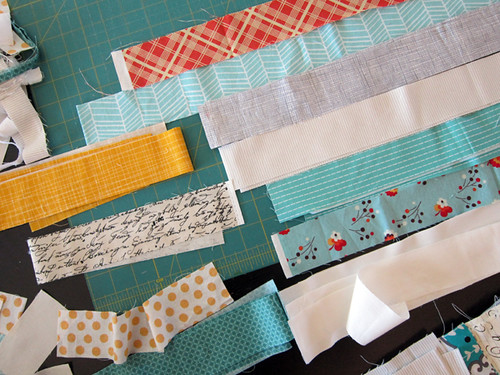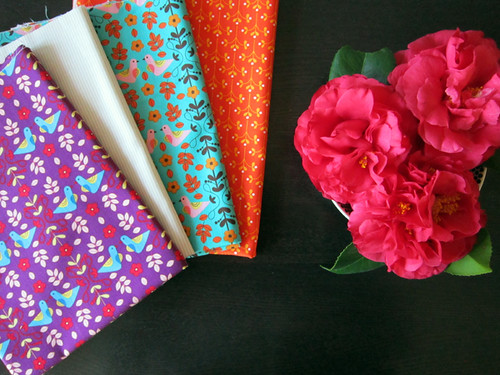helpful fabrics
So, I know that lots of folks have trouble choosing fabrics for a sewing project. I'm often asked for advice on this subject, but I'm really not sure how to give it. I think this is mostly a trial and error game, because it's so personal and so nuanced.
That said, I was reminded this last week that I have lots of help. Yes, I have lots and lots of helpful fabrics. Let's talk about that.

Helpful fabrics are...
Present. So, whether you have to go to the fabric store and play color schemes there or you are lucky enough to have a stash of sorts at home, either way you have to play with physical fabric to get very far. When making a bundle like I did last Monday, I pull out and put away so many fabrics (sometimes the same ones over and over again). It's seeing them together that allows me to make a decision. And, whenever possible, I do this in natural lighting so everything shines true.
Simple. When mixing fabrics from different collections, you're mixing art from different artists. The more personality a fabric holds, the less likely it is to blend with ease. Really helpful fabrics are often geometrics - dots, stripes, interlocking patterns, etc. In contrast, floral prints can easily fall into categories (vintage, abstract, super-detailed, etc.) that don't always merge well. And, novelty prints (birds, bathtubs, bears) take personality to a whole new level, usually requiring that a fabric assortment be designed entirely around them.
One-color. The fewer colors in any given print, the more versatile it will be. That's why people are often buying "textures" or "basics" that feature one color paired with a neutral. And, when you find yourself smitten with a geometric basic print that's available in lots of shades, it can be smart to invest in all the shades. Or, to be more precise, all the shades that you like and do not already have plenty of "basics" in at home.
In 2012 I was pretty good about buying mainly helpful prints. In fact, my stack of "multi-color" prints is waning. And, when I notice a hole in my fabric color palette (like emerald green, at the moment), I buy a few one-color simple prints to fill that hole so that I have a stocked palette on hand.
Take a look at the fabrics I included in my assortment last week. See how most of them are "helpful fabrics"?

After putting this together, I realized I wanted to add some low volume prints in ivory and pale gray to my future quilt, neither of which I have much of in my stash. Shopping around, I discovered a lovely taupe stripe called Ostara by Dear Stella at Intrepid Thread. It's sandwhiched between the colorful prints in the photo below. I've already used almost the entire half yard in my work. I should have ordered more!

I also ordered these three Kukla prints, which I've had my eye on for some time. These are decidedly unhelpful prints, with lots of color and personality. But, I've been sketching ideas for a Scandinavian motifs quilt. I think these colorful prints will fit in nicely. Plus, since they are small scale, they're realistic for quilting.
Ok, I hope that was a teeny bit useful for some. Bottom line is keep trying and be free to love what you love! Fabric wants to have fun.
That said, I was reminded this last week that I have lots of help. Yes, I have lots and lots of helpful fabrics. Let's talk about that.

Helpful fabrics are...
Present. So, whether you have to go to the fabric store and play color schemes there or you are lucky enough to have a stash of sorts at home, either way you have to play with physical fabric to get very far. When making a bundle like I did last Monday, I pull out and put away so many fabrics (sometimes the same ones over and over again). It's seeing them together that allows me to make a decision. And, whenever possible, I do this in natural lighting so everything shines true.
Simple. When mixing fabrics from different collections, you're mixing art from different artists. The more personality a fabric holds, the less likely it is to blend with ease. Really helpful fabrics are often geometrics - dots, stripes, interlocking patterns, etc. In contrast, floral prints can easily fall into categories (vintage, abstract, super-detailed, etc.) that don't always merge well. And, novelty prints (birds, bathtubs, bears) take personality to a whole new level, usually requiring that a fabric assortment be designed entirely around them.
One-color. The fewer colors in any given print, the more versatile it will be. That's why people are often buying "textures" or "basics" that feature one color paired with a neutral. And, when you find yourself smitten with a geometric basic print that's available in lots of shades, it can be smart to invest in all the shades. Or, to be more precise, all the shades that you like and do not already have plenty of "basics" in at home.
In 2012 I was pretty good about buying mainly helpful prints. In fact, my stack of "multi-color" prints is waning. And, when I notice a hole in my fabric color palette (like emerald green, at the moment), I buy a few one-color simple prints to fill that hole so that I have a stocked palette on hand.
Take a look at the fabrics I included in my assortment last week. See how most of them are "helpful fabrics"?

After putting this together, I realized I wanted to add some low volume prints in ivory and pale gray to my future quilt, neither of which I have much of in my stash. Shopping around, I discovered a lovely taupe stripe called Ostara by Dear Stella at Intrepid Thread. It's sandwhiched between the colorful prints in the photo below. I've already used almost the entire half yard in my work. I should have ordered more!

I also ordered these three Kukla prints, which I've had my eye on for some time. These are decidedly unhelpful prints, with lots of color and personality. But, I've been sketching ideas for a Scandinavian motifs quilt. I think these colorful prints will fit in nicely. Plus, since they are small scale, they're realistic for quilting.
Ok, I hope that was a teeny bit useful for some. Bottom line is keep trying and be free to love what you love! Fabric wants to have fun.
